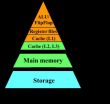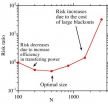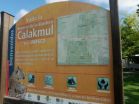(Press-News.org) Most drivers have experienced a traffic signal that turns yellow just as they approach an intersection, which makes it difficult for them to decide whether to stop or proceed through it. The wrong choice in this situation, known as the "dilemma zone," may lead to crashes, especially at high-speed intersections.
A major factor making driving difficult is hazards that are sudden and hard to predict. Roadside and in-vehicle display warning systems may help drivers handle these hazards by predicting their occurrence and providing advanced warning to the driver, according to a new study published in journal Human Factors.
Clemson University psychology professor and lead author on the paper Leo Gugerty and colleagues designed two driving simulator studies to compare the effectiveness of six types of roadway or in-vehicle warning systems. Participants were asked to navigate through traffic lights while their driving responses were measured based on the presence or absence of warning signals.
"In both studies, warnings led to more stopping at dilemma zone intersections and milder decelerations when stopping compared with no warning," said Gugerty. "Drivers' predominant response to warnings was anticipatory slowing on approaching the intersection, not speeding up."
These advanced warning systems could improve driver safety by potentially reducing crashes at signalized intersections. This study provides some evidence that intelligent dilemma zone warnings help drivers behave more safely when approaching them.
"Sometimes drivers respond to safety measures in ways that undo safety benefits, such as driving faster when using antilock brakes," he said. "However, the drivers in our simulator studies responded to the dilemma zone warning signals by driving more safely."
Results indicated that both roadway and in-vehicle warnings led to more stopping and milder decelerations at dilemma zone intersections. When given advanced warning, the participants rarely exhibited unsafe driving behavior, such as accelerating to beat the lights. In time, implementation of such systems could lead to fewer traffic-related injuries and fatalities.
These studies may provide guidance to human factors researchers regarding performance models of how drivers use end-of-green warnings, control algorithms and warning displays for intelligent intersections and statistical methodology in human factors research.
INFORMATION: END
Advanced warning systems increase safety at intersections, study shows
2014-04-08
ELSE PRESS RELEASES FROM THIS DATE:
Lipid levels during prenatal brain development impact autism: York U study
2014-04-08
In a groundbreaking York University study, researchers have found that abnormal levels of lipid molecules in the brain can affect the interaction between two key neural pathways in early prenatal brain development, which can trigger autism. And, environmental causes such as exposure to chemicals in some cosmetics and common over-the-counter medication can affect the levels of these lipids, according to the researchers.
"We have found that the abnormal level of a lipid molecule called Prostaglandin E2 in the brain can affect the function of Wnt proteins. It is important ...
Kinesin-5 structure opens cancer drug targets
2014-04-08
VIDEO:
Kinesin-5 plays a crucial role in cell division by allow microfilaments to slide past each other. The kinesin-5 structure shows a central rod connecting two motor units that walk along...
Click here for more information.
The structure of a key part of the machinery that allows cells to divide has been identified by researchers at the University of California, Davis -- opening new possibilities for throwing a wrench in the machine and blocking runaway cell division in cancer.
"The ...
Phase II trial of efatutazone shows challenge of matching treatment to population
2014-04-08
Work at the University of Colorado Cancer Center led to phase II trial of efatutazone with erlotinib in patients with refractory non-small cell lung cancer. Results are reported today at the American Association for Cancer Research (AACR) Annual Meeting 2014. While efatutazone did not improve the efficacy of erlotinib in this trial, researchers hope lessons from the trial will allow them to make better future use of the drug or other drugs in its class.
"In oncology and especially in lung cancer, everything is personalized. We're exploring different molecular markers ...
Glucosamine promotes longevity by mimicking a low-carb diet
2014-04-08
Glucosamine has been freely available in drugstores for many decades. It is widely used to treat arthritis and to prevent joint degeneration. Moreover, glucosamine is known to delay cancer growth. In addition, glucosamine reduces metabolism of nutritive sugars, as was already shown some 50 years ago.
In 2007, Michael Ristow showed that too much nutritive sugar shortens the lifespan of roundworms, a widely studied model organism in ageing research. Conversely, impairing carbohydrate metabolism in these worms was capable of extending lifespan [reference 1]. Unfortunately, ...
Future computers that are 'normally off'
2014-04-08
WASHINGTON D.C., April 8, 2014 -- If a research team in Japan gets its wish, "normally off" computers may one day soon be replacing present computers in a move that would both eliminate volatile memory, which requires power to maintain stored data, and reduce the gigantic energy losses associated with it.
Most parts of present computers are made with volatile devices such as transistors and dynamic random access memory (DRAM), which loses information when powered off. So computers are designed on the premise that power is "normally on."
Back in 2000, the concept of ...
Is the power grid too big?
2014-04-08
WASHINGTON D.C., April 8, 2014 -- Some 90 years ago, British polymath J.B.S. Haldane proposed that for every animal there is an optimal size -- one which allows it to make best use of its environment and the physical laws that govern its activities, whether hiding, hunting, hoofing or hibernating. Today, three researchers are asking whether there is a "right" size for another type of huge beast: the U.S. power grid.
David Newman, a physicist at the University of Alaska, believes that smaller grids would reduce the likelihood of severe outages, such as the 2003 Northeast ...
Rice U. study: Creativity and innovation need to talk more
2014-04-08
HOUSTON – (April 8, 2014) – Creativity and innovation are not sufficiently integrated in either the business world or academic research, according to a new study by Rice University, the University of Edinburgh and Brunel University.
The findings are the result of the authors' review of the rapidly growing body of research into creativity and innovation in the workplace, with particular attention to the period from 2002 to 2013.
"There are many of us who study employee creativity and many of us who study innovation and idea implementation, but we don't talk to each ...
The surprising truth about obsessive-compulsive thinking
2014-04-08
Montreal, April 8, 2014 — People who check whether their hands are clean or imagine their house might be on fire are not alone. New research from Concordia University and 15 other universities worldwide shows that 94 per cent of people experience unwanted, intrusive thoughts, images and/or impulses.
The international study, which was co-authored by Concordia psychology professor Adam Radomsky and published in the Journal of Obsessive-Compulsive and Related Disorders, examined people on six continents.
Radomsky and his colleagues found that the thoughts, images and ...
Where credit is due: How acknowledging expertise can help conservation efforts
2014-04-08
Scientists know that tapping into local expertise is key to conservation efforts aimed at protecting biodiversity – but researchers rarely give credit to these local experts. Now some scientists are saying that's a problem, both for the local experts and for the science itself.
To address the problem, a group of scientists is calling for conservation researchers to do a better job of publicly acknowledging the role of local experts and other non-scientists in conservation biology.
"For example, in the rainforests of the Yucatán, scientists couldn't even begin to do ...
Blocking DNA repair mechanisms could improve radiation therapy for deadly brain cancer
2014-04-08
DALLAS – April 8, 2014 – UT Southwestern Medical Center researchers have demonstrated in both cancer cell lines and in mice that blocking critical DNA repair mechanisms could improve the effectiveness of radiation therapy for highly fatal brain tumors called glioblastomas.
Radiation therapy causes double-strand breaks in DNA that must be repaired for tumors to keep growing. Scientists have long theorized that if they could find a way to block repairs from being made, they could prevent tumors from growing or at least slow down the growth, thereby extending patients' survival. ...




